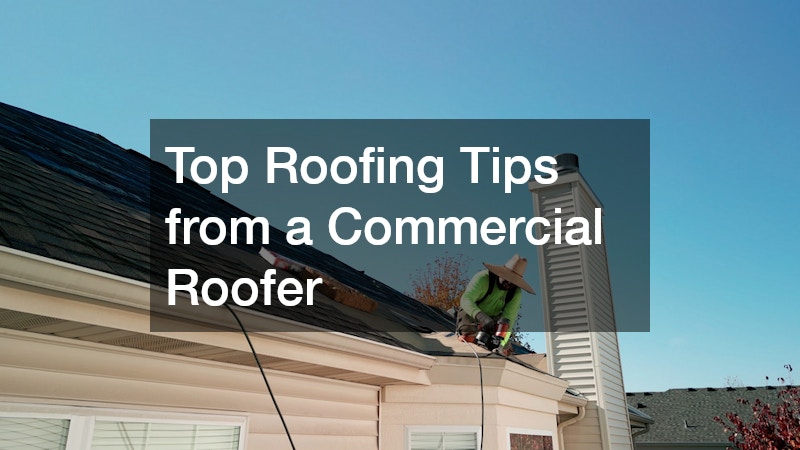Top Roofing Tips from a Commercial Roofer
Roofing is an essential component of any building structure, and maintaining it can save you from costly repairs. Whether you’re a business owner or managing a commercial property, understanding the basics from a professional roofer’s perspective can help prolong the life of your roof. In this article, we’ll address some of the most common questions business owners have when it comes to commercial roofing projects.
How Often Should a Commercial Roof be Inspected?
Commercial roofs should typically be inspected twice a year, ideally during the spring and fall. This bi-annual schedule helps to catch any weather-induced damage from the harsher seasons and prepares the roof for the upcoming climate changes.
Depending on the type of roofing material used, such as TPO or EPDM, adjustments in these frequencies might be necessary to ensure optimal maintenance.
Flat roofs, common in commercial properties, may require more frequent inspections due to their vulnerability to water pooling. Certain materials, like metal roofing, may demonstrate fewer issues over time, allowing for extended intervals between evaluations. However, each roofing material behaves differently under environmental pressures, necessitating tailored inspection schedules.
Factors Affecting Inspection Schedules
Several factors can affect the frequency of your roof’s inspection schedule, including the local climate and roof age. In areas prone to extreme weather conditions such as heavy rain, snow, or intense heat, more frequent checks are advisable to promptly identify damage. Roofs older than ten years need more frequent attention, as age naturally diminishes their life expectancy and resilience.
High foot traffic on roofs, common in urban setups, adds another layer of stress that necessitates increased inspection. Roofing installations surrounded by overhanging trees may need additional maintenance to prevent leaf and debris buildup, which can block drainage systems. Likewise, alterations or additions to the rooftop, such as new HVAC systems, may impact the structural integrity of the roof, requiring more frequent evaluations.
Wind exposure is another key factor that could influence roof inspections. Locations that routinely experience strong winds may necessitate regular evaluations to prevent wind-uplift damage. Business owners should adapt their inspection routines to these elements to preserve their roofing investment.
What are the Key Signs of Roofing Damage?
Visual Cues from Ground Level
Business owners can often tell if their roof is damaged through visual cues observable from ground level. Water spots or leaks on interior ceilings are immediate giveaways of potential roofing issues. Discoloration or streaked-looking exterior walls can also suggest that the roof isn’t directing water properly.
Additionally, if roofing materials like shingles or metal panels appear loose or missing, it’s an indication that action is necessary. Gutters filled with granules from asphalt shingles or metal roofing indicate significant wear. Keeping an eye out for these signs promptly alerts owners to possible failures needing professional attention from a commercial roofer.
Subtle Indicators of Trouble
Beyond obvious visual signs, some subtle indicators might suggest roofing problems are developing. An unexplained increase in energy bills can be an indication of roofing issues, as inefficiencies in insulation may cause heating or cooling systems to work harder. Similarly, changes in the indoor climate, like drafts or unusual moisture, can signal roofing insulation problems.
Persistent or unexplained odors, particularly those hinting at mold or mildew, suggest possible water intrusion that may originate from the roof. Additionally, unusual sounds during windy conditions, such as rattling or flapping, could indicate loose roofing materials or compromised structural elements. These less overt signs require diligence and further investigation to avert larger issues.
What Materials are Best for a Commercial Roof?
The choice of roofing material is crucial in determining a roof’s effectiveness and longevity. TPO, or Thermoplastic Olefin, is popular for its energy efficiency and heat-reflective properties, ideal for climate control in warmer regions. EPDM (Ethylene Propylene Diene Monomer) is renowned for its durability and excellent performance in extreme temperatures.
Metal roofs offer longevity and excellent protection against the elements, though they come with a higher initial cost. Built-Up Roofs (BUR) are another popular option, known for their layer-based protection and time-tested performance. Each material offers distinct advantages, which merit consideration based on specific building needs.
Pros and Cons of Different Materials
Every roofing material has its unique set of pros and cons that might influence your choice. TPO roofing is lauded for its reflective surface and cost-effectiveness but can be susceptible to punctures. EPDM, with its elastic properties, provides excellent weather resistance but might require additional insulation to maximize energy efficiency.
Metal roofs provide unmatched durability, often lasting decades, but their heavier weight demands robust structural support. BUR’s layered system ensures protection and insulation, though installation is time-consuming and might carry higher labor costs. Hence, prioritizing attributes that align with building usage and external conditions is essential for optimal results.
Maintaining the integrity of a commercial roof is crucial for the protection and efficiency of a building. Regular inspections, knowing the signs of damage, and choosing the right materials can help extend the life of the roof. By implementing these tips, business owners can protect their investments and maintain a safe environment.
.


